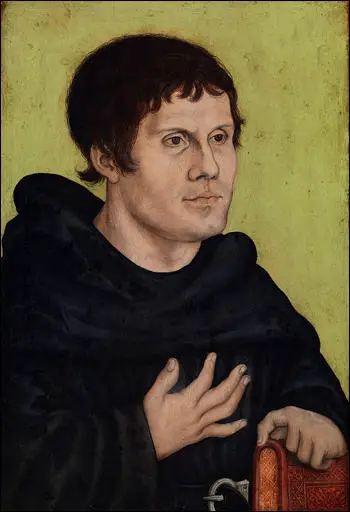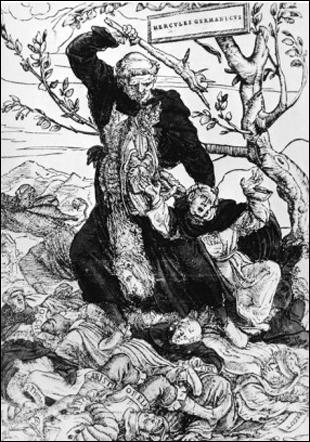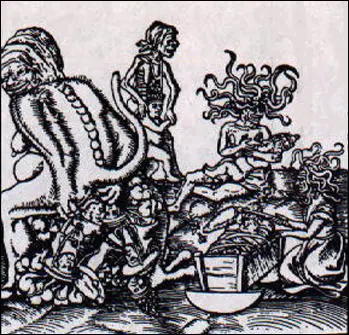Martin Luther and the Reformation
In 1508 Martin Luther began studying at the newly founded University of Wittenberg. He was awarded his Doctor of Theology on 21st October 1512 and was appointed to the post of professor in biblical studies. He also began to publish theological writings. Luther began to question traditional Catholic teaching. This included the theology of humility (whereby confession of one's own utter sinfulness is all that God asks) and the theology of justification by faith (in which human beings are seen as incapable of any turning towards God by their own efforts).
In 1516, Johann Tetzel, a Dominican friar arrived in Wittenberg. He was selling documents called indulgences that pardoned people for the sins they had committed. Tetzel told people that the money raised by the sale of these indulgences would be used to repair St. Peter's Basilica in Rome. Luther was very angry that Pope Leo X was raising money in this way. He believed that it was wrong for people to be able to buy forgiveness for sins they had committed. Luther wrote a letter to the Bishop of Mainz, Albert of Brandenburg, protesting the sale of indulgences.
On 31st October, 1517, Martin Luther affixed to the castle church door, which served as the "black-board" of the university, on which all notices of disputations and high academic functions were displayed, his Ninety-five Theses. The same day he sent a copy of the Theses to the professors of the University of Mainz. They immediately agreed that they were "heretical". For example, Thesis 86, asks: "Why does not the pope, whose wealth today is greater than the wealth of the richest Crassus, build the basilica of St. Peter with his own money rather than with the money of poor believers?"
Pope Leo X ordered Luther to stop stirring up trouble. This attempt to keep Luther quiet had the opposite effect. Luther now started issuing statements about other issues. For example, at that time people believed that the Pope was infallible (incapable of error). However, Luther was convinced that Leo X was wrong to sell indulgences. Therefore, Luther argued, the Pope could not possibly be infallible.
Primary Sources

(Source 2) Jasper Ridley, Henry VIII (1984)
All the sovereigns of Europe supported the Pope against Luther. The Kings had often quarrelled with the Popes about money and foreign policy; but a popular movement which attacked Papal authority was a seditious threat to the social order of Christendom which could soon lead to revolutionary attacks on the authority of Kings and on the privileges and property of the nobility and the wealthy classes... The outbreak of the Peasant War in Germany in 1525... made Henry VIII, like his brother Kings, a determined enemy of Lutheranism.
(Source 3) Martin Luther, To the Christian Nobility of the German Nation (1520)
The German nation and empire must be freed to live their own lives. The princes must make laws for the moral reform of the people, restraining extravagance in dress or feasts or spices, destroying the public brothels, controlling the bankers and credit.
(Source 4) Jasper Ridley, The Statesman and the Fanatic (1982)
From the beginning there was a fundamental difference between Erasmus and Luther, between the humanists and the Lutherans. The humanists wished to remove the corruptions and to reform the Church in order to strengthen it; the Lutherans, almost from the beginning, wished to overthrow the Church, believing that it had become incurably wicked and was not the Church of Christ on earth.
(Source 5) Martin Luther, comment to Emperor Charles V (18th April 1521)
Unless I am proved wrong by Scriptures or by evident reason, then I am a prisoner in conscience to the Word of God. I cannot retract and I will not retract. To go against the conscience is neither safe nor right. God help me.
(Source 6) Henry Ganss, The Catholic Encyclopedia (1910)
Luther the reformer had become Luther the revolutionary; the religious agitation had become a political rebellion... Luther had one prominent trait of character, which in the consensus of those who have made him a special study, overshadowed all others. It was an overweening confidence and unbending will, buttressed by an inflexible dogmatism. He recognized no superior, tolerated no rival, brooked no contradiction.

(Source 8) Victor S. Navasky, The Art of Controversy (2012)
Hans Holbein... created a woodcut depicting Martin Luther as "the German Hercules," in which Luther beats scholastics as Aristotle and St. Thomas Aquinas into submission with a nail-studded club.
Luther commissioned such artists as Lucas Cranach the elder to make woodcuts in support of the Reformation, among them "The Birth and Origin of the Pope" (one of the series entitled The True Depiction of the Papacy, which depicts Satan excreting the Pontiff). He also commissioned Cranach to provide cartoon illustrations for his German translation of the New Testament, which became a best seller, a major event in the history of the Reformation.
(Source 9) Derek Wilson, Out of the Storm: The Life and Legacy of Martin Luther (2007)
What was clever about this print (and what has made it difficult for later ages to determine its true message) was that it was capable of various interpretations. Followers of Luther could see their champion represented as a truly god-like being of awesome power, the agent of divine vengeance. Classical scholars, delighting in the many subtle allusions (such as the representation of the triple-tiaraed pope as the three-bodied monster, Geryon) could applaud the vivid representation of Luther as the champion of falsehood over medieval error. Yet, papalists could look on the same image and see in it a vindication of Leo's description of the uncouth German as the destructive wild boar in the vineyard and, for this reason, the engraving received a very mixed reception in Wittenberg.
(Source 10) Owen Chadwick, The Reformation (1964)
He (Martin Luther) began to translate the New Testament into German. He had determined that the Bible should be brought to the homes of the common people. He echoed the cry of Erasmus that the ploughman ought to be able to recite the Scripture while he was ploughing, or the weaver as he hummed to the music of his shuttle. He took a little more than a year to translate the New Testament and have it revised by his young friend and colleague Philip Melanchthon... The simplicity, the directness, the freshness, the perseverance of Luther's character appeared in the translation, as in everything else that he wrote.

(Source 12) Derek Wilson, Out of the Storm: The Life and Legacy of Martin Luther (2007)
With the New Testament Luther staked a place at the very forefront of the development of German literature. His style
was vigorous, colourful and direct. Anyone reading it could almost hear the author proclaiming the sacred text and that was no fortuitous accident; Luther's written language was akin to the oral delivery of his own impassioned sermons. His translation was couched in compelling prose....
Luther did not hesitate to point out the contemporary application of first-century teaching. For example, the papacy was clearly identified as the beast of Revelation in Luther's glosses and the vivid woodcuts provided by Lucas Cranach. Luther's New Testament was the campaign manual of the Reformation...
This phenomenon that appeared in England a few years later had its beginning in Germany in the early 1520s. Bible mania is something the modern reader may well find difficult to understand. In an age when the Bible remains the least read best-seller and is widely regarded as out-dated and irrelevant we find it hard to get inside the minds of people who risked arrest, imprisonment and death by owning, reading and selling copies of the sacred text. Luther's New Testament was, of course, banned and, of course, that only boosted sales....
But it was.not just the serum of a purified biblical text that Luther set coursing through the veins of Germany. Translation implies interpretation and it was his exposition of the New Testament message that made such a dramatic impact.... This was far and away the most important contribution of Martin Luther to the history of religion.
(Source 13) Peter Ackroyd, Tudors (2012)
In the autumn of 1517 Martin Luther spoke out, lending a more fiery and dogmatic charge to the general calls for reform.... In a series of pamphlets Luther attacked the beliefs and hierarchies of the orthodox faith. The pope in Rome was the Antichrist...
Luther's books came into the country, from the ports of the Low Countries and from the cities of the Rhineland, as contraband smuggled in sacks of cloth... Henry was never warmly disposed towards Lutheranism and, in most respects, remained an orthodox Catholic...
Wolsey suggested to the king that he might care to be distinguished from other European princes by showing himself to be erudite as well as orthodox. So with the help of royal servants such as Thomas More the king composed a reply to Luther entitled, In Defence of the Seven Sacraments.
It was not a brilliant or enthralling work, but it served its purpose. The pope professed to be delighted by it, and conferred on Henry the title of "Defender of the Faith".
(Source 14) Roger Lockyer, Tudor and Stuart Britain (1985)
In 1517 Martin Luther had made his celebrated challenge to the Papacy and had thereby set off a reform movement that threatened to split the Christian church into warring fragments. Henry did not approve of Luther, and regarded many of his beliefs as heretical... Yet Lutheran influences were already at work in England, and there was a very real possibility that Henry, by undermining the authority of the ecclesiastical hierarchy, might cripple the Church at a time when it needed all its strength to combat heresy.
Questions for Students
Question 1: Read the introduction. Why was Martin Luther so critical of Pope Leo X.
Question 2: Study sources 2 to 6. (a) Why did some kings and princes find Martin Luther's ideas attractive? (b) Why did most kings and princes find his ideas dangerous? (c) Select the source that is most hostile to Martin Luther and explain why he might have this point of view.
Question 3: Use the information in sources 8 and 9 to explain source 7.
Question 4: According to the authors of sources 10 and 12, why was Martin Luther's translation of the Bible into German so important?
Question 5: Can you explain the meaning of source 11.
Question 6: Was Henry VIII a supporter of Martin Luther?
Answer Commentary
A commentary on these questions can be found here
